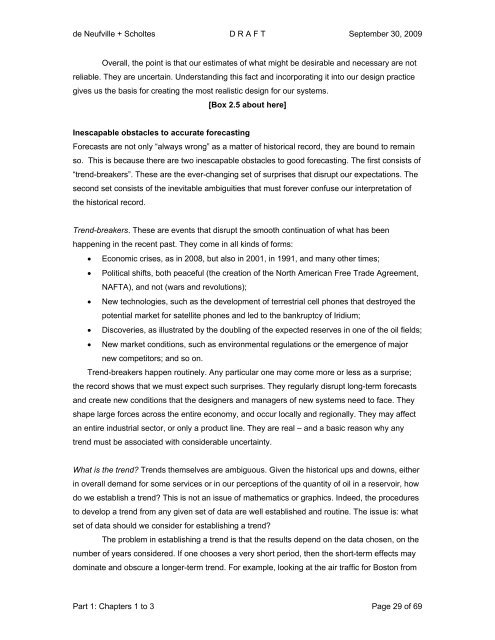FLEXIBILITY IN DESIGN - Title Page - MIT
FLEXIBILITY IN DESIGN - Title Page - MIT
FLEXIBILITY IN DESIGN - Title Page - MIT
You also want an ePaper? Increase the reach of your titles
YUMPU automatically turns print PDFs into web optimized ePapers that Google loves.
de Neufville + Scholtes D R A F T September 30, 2009Overall, the point is that our estimates of what might be desirable and necessary are notreliable. They are uncertain. Understanding this fact and incorporating it into our design practicegives us the basis for creating the most realistic design for our systems.[Box 2.5 about here]Inescapable obstacles to accurate forecastingForecasts are not only “always wrong” as a matter of historical record, they are bound to remainso. This is because there are two inescapable obstacles to good forecasting. The first consists of“trend-breakers”. These are the ever-changing set of surprises that disrupt our expectations. Thesecond set consists of the inevitable ambiguities that must forever confuse our interpretation ofthe historical record.Trend-breakers. These are events that disrupt the smooth continuation of what has beenhappening in the recent past. They come in all kinds of forms:• Economic crises, as in 2008, but also in 2001, in 1991, and many other times;• Political shifts, both peaceful (the creation of the North American Free Trade Agreement,NAFTA), and not (wars and revolutions);• New technologies, such as the development of terrestrial cell phones that destroyed thepotential market for satellite phones and led to the bankruptcy of Iridium;• Discoveries, as illustrated by the doubling of the expected reserves in one of the oil fields;• New market conditions, such as environmental regulations or the emergence of majornew competitors; and so on.Trend-breakers happen routinely. Any particular one may come more or less as a surprise;the record shows that we must expect such surprises. They regularly disrupt long-term forecastsand create new conditions that the designers and managers of new systems need to face. Theyshape large forces across the entire economy, and occur locally and regionally. They may affectan entire industrial sector, or only a product line. They are real – and a basic reason why anytrend must be associated with considerable uncertainty.What is the trend? Trends themselves are ambiguous. Given the historical ups and downs, eitherin overall demand for some services or in our perceptions of the quantity of oil in a reservoir, howdo we establish a trend? This is not an issue of mathematics or graphics. Indeed, the proceduresto develop a trend from any given set of data are well established and routine. The issue is: whatset of data should we consider for establishing a trend?The problem in establishing a trend is that the results depend on the data chosen, on thenumber of years considered. If one chooses a very short period, then the short-term effects maydominate and obscure a longer-term trend. For example, looking at the air traffic for Boston fromPart 1: Chapters 1 to 3 <strong>Page</strong> 29 of 69
















